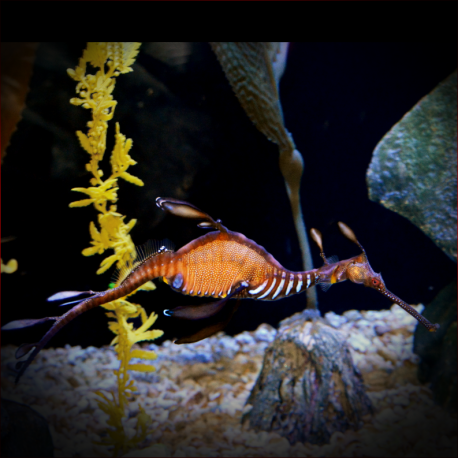More info
Datasheet
| Minimum Tank Size | Unknown |
| Maximum Size | 46.0cm / 18.11inches |
| Reef Compatible | Always reef safe |
| Temperament | Peaceful |
| Temperature | 22.2°C / 71.96°F - 25.6°C / 78.08°F |
| Specific Gravity | 1.020-1.025 |
| Carbonate Hardness | 8-12 |
| pH | 8.1-8.4 |
General Description:
The Common Seadragon, scientifically known as Phyllopteryx taeniolatus, belongs to the Syngnathidae family, specifically under the Syngnathidae - Phyllopteryx genus. This species, endemic to Australia, can grow up to 46.0cm in size and is primarily found in the wild along the Australian coast.
Aquarium Suitability:
The Common Seadragon requires a specialized setup in captivity, making them suitable for experienced aquarists who are willing to dedicate extra care and preparation towards their needs. Due to their unique characteristics and delicate nature, providing a suitable environment is crucial for their well-being in an aquarium setting.
Demands, Care, and Hardiness:
While the hardiness of the Common Seadragon is unknown, they are known to be peaceful in temperament, requiring water conditions with a pH range of 8.1-8.4, a specific gravity of 1.020-1.025, and a temperature between 22.2-25.6°C. These creatures do not have stringent water quality requirements but do need a well-maintained aquarium to thrive.
Reef Suitability and Aquarium Setup:
Common Seadragons are deemed reef-safe, making them a suitable addition to a reef tank. When setting up the aquarium, it is essential to provide structures for them to latch onto, such as kelp or macroalgae, while avoiding corals and anemones that could harm them. A gentle water current is preferred, as these creatures are not strong swimmers. Keeping them in smaller tanks, ideally around 40 liters, can aid in controlling feeding and water quality.
Behaviour:
These seadragons exhibit peaceful behavior in an aquarium setting, requiring a calm environment with minimal stressors. They may spend their time exploring their surroundings or grasping onto suitable structures in the tank.
Feeding and Diet:
The recommended diet for Common Seadragons includes small crustaceans like krill and mysis, as well as zooplankton such as cyclops and pods. To ensure proper nutrition, supplementing their diet with omega-3 fatty acids and vitamins is beneficial. Captive-bred specimens are often easier to feed compared to wild-caught individuals, as they are more accustomed to consuming frozen foods.
Dimorphism and Captive Reproduction:
Information regarding dimorphism and captive reproduction of Common Seadragons is not provided in the available data. However, it is noted that these unique creatures can be successfully bred in captivity, offering a sustainable option for aquarium enthusiasts interested in adding them to their collection.
Habitat and Distribution:
Found primarily along the Australian coast, Common Seadragons inhabit seagrass beds and rocky reefs in shallow coastal waters. Their natural habitat features seaweed-rich environments that offer camouflage and protection from predators.

